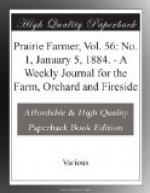Indiana correspondent Orange County Farmer: I have had a good deal of experience in propagating currants. I always plant my currant cuttings in the fall as soon as the leaves fall off. They will make durable roots two to four inches long the same fall, while the buds remain dormant. They will make double the growth the next season if set in the fall, and they should be set in ground that will not heave them out by the effects of frost and should be covered just before winter sets in with coarse litter. Remove the covering early in the spring and examine the cuttings to see if any of them hove, and if so, press them down again. Should they heave up an inch or more, if well pressed down, they will start and make better growth than cuttings set in the spring. In either case, however, the cuttings should always be made in the fall.
A Rural New Yorker correspondent gets down to the real art of grape eating. Hear him tell how to manipulate the fruit: No! the man who holds the grape between his thumb and dexter finger and squeezes or shoots the pulp into his throat, does not know how to enjoy the fruit, and is not likely to appreciate the good qualities of a fine grape. Let the berries follow each other into the mouth in rapid succession until three or four are taken, while with each insertion the teeth are brought together upon the seeds without breaking them. The acid of the pulp is thus freed to mingle with the saccharine juice next the skin, and a slight manipulation by the tongue separates the seeds and skins from the delicious winey juices; after this has tickled the palate, skins and seeds may be ejected together. Close to the skin lies a large part of the good flavor of the grape.
On the subject of protecting trees from mice, R.W. Rogers, in Ohio Farmer says: “As the season is near at hand when farmers will have to look to the protection of their young fruit trees from ground mice, I send you my method if you deem it worthy of publishing. It is as follows: Take old tin fruit cans, put them on the fire until the parts that are soldered have become heated, when they will come apart. Take the body of the can and encircle it around the tree, letting the sides lap each other, and press firmly in the ground before it has become frozen. The mice coming in contact with the tin will turn them in another direction. It is far better than mounding up or tramping snow about them. Most any farmer can gather up enough for a good sized orchard, and make them pay compound interest, which otherwise would be a nuisance or pitched out of the back window.”
FLORICULTURE.
Gleanings by an Old Florist.




